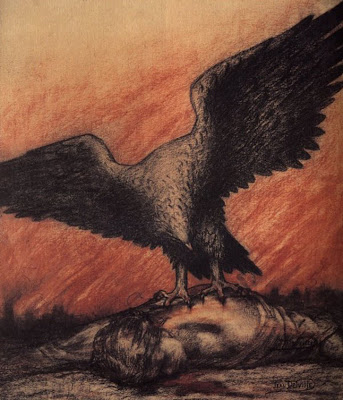
The Portrait of Mrs. Stuart Merrill (1892)
Jean Delville (1867–1953) was a Belgian symbolist painter, writer, and occultist. During the last decades of the 19th century, many people in the West reacted to the materialism and hypocrisy of the period by developing an interest in esoteric, occult and spiritual subjects. The enthusiasm for these ideas reached its peak during the 1890s, the decade when the Belgian painter and writer Jean Delville was at the height of his powers.

 Delville became committed to spiritual and esoteric subjects during his early twenties. In 1887 or 1888 he spent a period in Paris, where he met Sâr Joséphin Péladan, an eccentric mystic and occultist, who defined himself as a modern Rosicrucian, descended from the Persian Magi. Delville was struck by a number of Péladan’s ideas, among them his vision of the ideal artist as a spontaneously developed initiate, whose mission was to send light, spirituality and mysticism into the world. He exhibited paintings in Péladan's Salons between 1892 and 1895.
Delville became committed to spiritual and esoteric subjects during his early twenties. In 1887 or 1888 he spent a period in Paris, where he met Sâr Joséphin Péladan, an eccentric mystic and occultist, who defined himself as a modern Rosicrucian, descended from the Persian Magi. Delville was struck by a number of Péladan’s ideas, among them his vision of the ideal artist as a spontaneously developed initiate, whose mission was to send light, spirituality and mysticism into the world. He exhibited paintings in Péladan's Salons between 1892 and 1895.

 Despite all his work and ability, however, Delville never achieved the recognition he would have liked. As Brendan Cole says in his thesis, he almost certainly paid a price for refusing to compromise his ideals. By 1951, Delville had become almost completely ignored and forgotten. He died two years later and did not live to see the revival of interest in his work. This was marked by exhibitions in London in 1968, and Paris in 1972. Today Delville’s pictures are once again recognised for their unusual qualities. Although they do not correspond with everyone’s taste, many people now see them as outstanding and fascinating expressions of otherworldly subjects.
Despite all his work and ability, however, Delville never achieved the recognition he would have liked. As Brendan Cole says in his thesis, he almost certainly paid a price for refusing to compromise his ideals. By 1951, Delville had become almost completely ignored and forgotten. He died two years later and did not live to see the revival of interest in his work. This was marked by exhibitions in London in 1968, and Paris in 1972. Today Delville’s pictures are once again recognised for their unusual qualities. Although they do not correspond with everyone’s taste, many people now see them as outstanding and fascinating expressions of otherworldly subjects.
Satan’s Treasures (1895)
One of Delville’s best works is "Satan’s Treasures", first exhibited in 1895. Here the artist depicts Satan with a wild, fiery head of hair and huge red tentacles instead of wings. Scarlet waves surround his left arm, as he presides over a river of unconscious men and women. The nude bodies of these figures appear orange and yellow in reproductions, but in the original they are a subtle mixture of acid pinks and yellows, highlighted with touches of green. They lie transfixed in the centre of a luxuriant coral reef, surrounded by coins, jewels and strange fish. Beyond the reef one can see vast vistas filled with jagged rock formations, and painted in shades of orange, yellow and brown.
Though the full interpretation is again left to the viewer, it clear that Satan’s Treasures is not a traditional vision of hell. It reveals a fascination with decadence and the erotic which was typical of the period. At the same time there is probably an underlying theme of initiation.
Delville’s vast undersea world, ruled by Satan, is almost certainly an image of the material abyss. Satan, lord of the physical realm, presides over its sleeping inhabitants. Wrapped in delusion, the dreaming men and women are mesmerised by Satan’s spell, and trapped by their own desires. Satan’s “treasures” include not only their sensuality, but also their attraction to worldly riches, represented by the pearls, coins and corals which surround them. Above all, the entranced people themselves are the treasures of Satan.
Swedish Thrash Metal band Hexenhaus used this painting for the cover of their album "A Tribute to Insanity" (1988), while American death metal group Morbid Angel used this painting also for the cover of their second album, "Blessed Are the Sick" (1991).





















.jpg)




oh, yes! I know. I have already posted two sets for Giger
ΑπάντησηΔιαγραφή